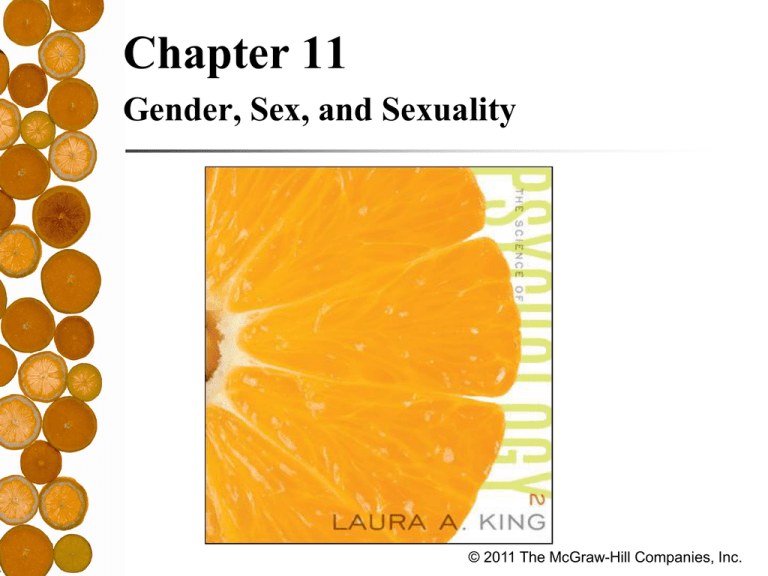
Chapter 11
Gender, Sex, and Sexuality
© 2011 The McGraw-Hill Companies, Inc.
Chapter Preview
Defining Sex and Gender
Theories of Gender Development
Gender Differences
Sexual Orientation
Sexual Behaviors and Practices
Sexual Variations and Disorders
Sexuality and Health and Wellness
© 2011 The McGraw-Hill Companies, Inc.
Defining Sex
Properties that determine male or female
23rd pair of chromosomes: XY or XX
gonads (ovaries, testes)
gonadal hormones: estrogens or androgens
internal reproductive structures
external genitalia
secondary sex characteristics (at puberty)
© 2011 The McGraw-Hill Companies, Inc.
Defining Gender
…social and psychological aspects
of being female or male
Gender Identity
masculinity (instrumentality)
femininity (expressiveness)
androgyny (both)
© 2011 The McGraw-Hill Companies, Inc.
Sexual Development
embryonic development of gonads and genitalia
SRY gene testes androgens male physiology
female is “default” condition
gender differences in regards to the brain
- size of brain parts
- function of brain parts
- corresponding cognitive function
- which part of brain involved in particular
behaviors
© 2011 The McGraw-Hill Companies, Inc.
Sexual Development
Disorders of Sexual Development
- congenitally atypical chromosomal, gonadal, or
anatomical development
- questions of relation of DSD to gender development
Transgender Experience
Gender Identity Disorder
- not considered a disorder in France or Great Britain
- gender dysphoria
- sex reassignment surgery
© 2011 The McGraw-Hill Companies, Inc.
Gender Development
Biological Accounts
behavioral difference in newborns and infants
Evolutionary Accounts
selection pressures for gendered behaviors
- competition for mate (usually by male)
- preferences/choice for quality mate (usually by female)
- reproductive challenges: quality v. quantity
© 2011 The McGraw-Hill Companies, Inc.
Gender Development
Social Cognitive Accounts
experience influences sense of gender
socialization (rewards, punishments, modeling)
gender schema (mental framework)
Social Role Theory
division of labor
- natural differences become expected/valued differences
- gender roles and gender stereotypes
© 2011 The McGraw-Hill Companies, Inc.
Gender Differences
Who are more ___________?
For each adjective on the next slide,
answer as quickly as you can with
either “men” or “women”.
© 2011 The McGraw-Hill Companies, Inc.
Gender Differences
Who are more . . .
assertive
emotional
strong
creative
verbal
rational
aggressive
sexually adventurous
reserved
active
© 2011 The McGraw-Hill Companies, Inc.
Gender Differences
Cognitive Differences
math and science?
verbal performance (female advantage)
visuospatial ability (male advantage)
general intelligence (no advantage)
Differences due to:
- social expectations and support v. evolved roles
- gender similarities hypothesis
© 2011 The McGraw-Hill Companies, Inc.
Gender Differences
Differences in Aggression
overt aggression (physical/verbal harm)
- males more than females
relational aggression (harm social standing)
- females more than males
why the difference?
testosterone?
evolutionary pressures?
socialization?
© 2011 The McGraw-Hill Companies, Inc.
Gender Differences
Differences in Sexuality
females more selective in regards to casual sex
males more often aroused, stronger sex drive, less fidelity
women more likely to engage in bisexuality or be aroused
by bisexual stimuli
Explanations:
biological - genetic/hormonal differences
evolutionary - sexual selection
social cognitive - learned behavior
social role - culturally constructed
© 2011 The McGraw-Hill Companies, Inc.
Sexual Orientation
…direction of erotic interests - refers to
more than just sexual behavior
Orientations:
- heterosexual (90% of population)
- homosexual
- bisexual
© 2011 The McGraw-Hill Companies, Inc.
Sexual Orientation
Orientation is not influenced by…
being reared by a gay parent
parenting style
childhood sexual experimentation
© 2011 The McGraw-Hill Companies, Inc.
Origins of Sexual Orientation
Thinking critically about sexual orientation:
probably not a single cause
within-group variation
research challenges such as recruitment
meaning of cross-sex similarities
consideration of more than just homosexuality
© 2011 The McGraw-Hill Companies, Inc.
Sexual Orientation
Orientation is influenced by
genetics
corpus callosum thickness and hemispheric
symmetry
prenatal hormones
social factors (gender non-conforming
behavior)
© 2011 The McGraw-Hill Companies, Inc.
Gay and Lesbian Functioning
similarities to heterosexual population
- attitudes, psychological adjustment
difference from heterosexual population
- hobbies, activities, occupations
coping with prejudice and discrimination
- coming out
© 2011 The McGraw-Hill Companies, Inc.
Gay and Lesbian Functioning
Relationships
report greater satisfaction than heterosexuals
more likely to end relationships than
heterosexuals
Families
less likely to have children
children of gay couples have not shown
differences from other children
© 2011 The McGraw-Hill Companies, Inc.
Sexual Behavior
What constitutes sexual behavior?
infidelity or loss of virginity
activities involved in reproduction
arousal and sexual response
unusually intimate and personal activity as
defined by the participants
© 2011 The McGraw-Hill Companies, Inc.
Sexual Behavior
Kinsey’s (1948) research
are most people promiscuous or faithful?
does marriage decrease sexual activity?
what percentage of the population are virgins?
how often do we have sex (on average)?
who masturbates the most?
© 2011 The McGraw-Hill Companies, Inc.
Sexual Response Pattern
Human Sexual Response Pattern
1. excitement
2. plateau
3. orgasm
4. resolution/male refractory period
© 2011 The McGraw-Hill Companies, Inc.
Sexual Cognition
Cognitive factors in sexual behavior
self-monitoring and self-regulation
fantasy and imagery
sexual scripts
© 2011 The McGraw-Hill Companies, Inc.
Influences on Sexuality
Influence of Culture
Inis Beag
Mangaia
Sex Education
abstinence-only v. comprehensive
© 2011 The McGraw-Hill Companies, Inc.
Sexual Variations & Disorders
fetishes
paraphilias
pedophilia
disorders of sexual desire/response
female dysfunction in arousal
erectile dysfunction, premature ejaculation
© 2011 The McGraw-Hill Companies, Inc.
Sexuality and
Health and Wellness
Sexually Transmitted Infections
bacterial: gonorrhea, syphilis
viruses: genital herpes, HIV
Safe Sex
abstinence 100% effective
risk reduction with condom use
Psychological Well-Being
sexual activity is predictor of satisfaction in
relationships
© 2011 The McGraw-Hill Companies, Inc.
Chapter Summary
Define the terms “sex” and “gender”.
Explain the biological, evolutionary, social-cognitive,
and social role accounts of gender development.
Summarize the well-documented gender differences.
Describe the similarities and differences among gays,
lesbians, and heterosexuals.
Discuss sexual variations and disorders.
Explain how sexuality affects health and wellness.
© 2011 The McGraw-Hill Companies, Inc.
Chapter Summary
Defining Sex and Gender
Theories of Gender Development
biological
evolutionary
social-cognitive
social roles
Gender Differences
© 2011 The McGraw-Hill Companies, Inc.
Chapter Summary
Sexual Orientation
influences on sexual orientation
gay and lesbian functioning and relationships
Sexual Behavior
sexual activity
human sexual response pattern
Sexual Disorders
Sexuality and Health and Wellness
sexually transmitted infections
© 2011 The McGraw-Hill Companies, Inc.








